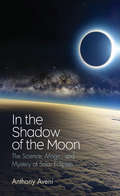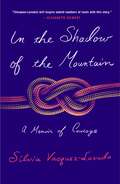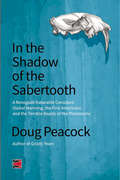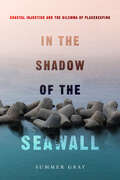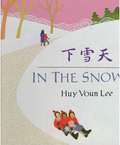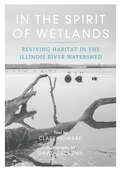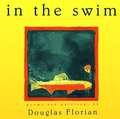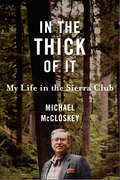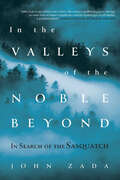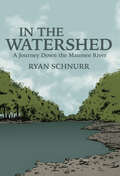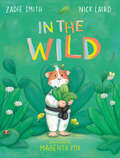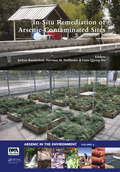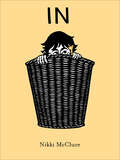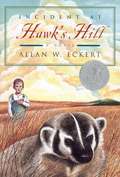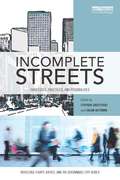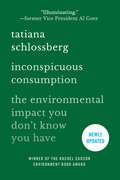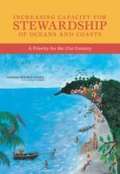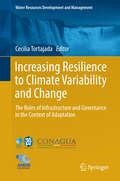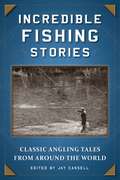- Table View
- List View
In the Shadow of the Moon: The Science, Magic, and Mystery of Solar Eclipses
by Anthony AveniFrom an award-winning author, astronomer, and anthropologist, an exploration of the scientific and cultural significance of the mesmerizing cosmic display.Since the first humans looked up and saw the sun swallowed by darkness, our species has been captivated by solar eclipses. Astronomer and anthropologist Anthony Aveni explains the history and culture surrounding solar eclipses, from prehistoric Stonehenge to Babylonian creation myths, to a confirmation of Einstein&’s theory of general relativity, to a spectacle that left New York City in the moon&’s shadow, to future eclipses that will capture human imaginations.In one accessible and engaging read, Aveni explains the science behind the phenomenon, tracks eclipses across the ancient world, and examines the roles of solar eclipses in modern times to reveal the profound effects these cosmic events have had on human history. Colored by his own experiences—Aveni has witnessed eight total solar eclipses in his lifetime—his account of astronomy&’s most storied phenomenon will enthrall anyone who has looked up at the sky with wonder.&“Aveni&’s authoritative but accessible text is the clearest statement of the way our perception of eclipses has changed over the centuries.&” —Stuart Clark, New Scientist&“Authoritative and engaging.&” —Marcelo Gleiser, NPR&’s 13.7&“A recommended way to share the spirit of the occasion.&” —Laurence A. Marschall, Natural History magazine&“Everything you need to enjoy a solar eclipse—and even predict one, just like the Babylonians did! Aveni&’s entertaining explorations show the very different impacts eclipses have had on past and present cultures.&” —David DeVorkin, National Air and Space Museum, Smithsonian Institution
In the Shadow of the Mountain: A Memoir of Courage
by Silvia Vasquez-Lavado“In climbing the Seven Summits, Silvia Vasquez-Lavado did nothing less than take back her own life—one brave step at a time. She will inspire untold numbers of souls with this story, for her victory is a win on behalf of all of us.”—Elizabeth GilbertEndless ice. Thin air. The threat of dropping into nothingness thousands of feet below. This is the climb Silvia Vasquez-Lavado braves in her page-turning, pulse-raising memoir following her journey to Mount Everest.A Latina hero in the elite macho tech world of Silicon Valley, privately, she was hanging by a thread. Deep in the throes of alcoholism, hiding her sexuality from her family, and repressing the abuse she’d suffered as a child, she started climbing. Something about the brute force required for the ascent—the risk and spirit and sheer size of the mountains and death’s close proximity—woke her up. She then took her biggest pain as a survivor to the biggest mountain: Everest.“The Mother of the World,” as it’s known in Nepal, allows few to reach her summit, but Silvia didn’t go alone. She gathered a group of young female survivors and led them to base camp alongside her. It was never easy. At times hair-raising, nerve-racking, and always challenging, Silvia remembers the acute anxiety of leading a group of novice climbers to Everest’s base, all the while coping with her own nerves of summiting. But, there were also moments of peace, joy, and healing with the strength of her fellow survivors and community propelling her forward.In the Shadow of the Mountain is a remarkable story of heroism, one which awakens in all of us a lust for adventure, an appetite for risk, and faith in our own resilience.
In the Shadow of the Sabertooth
by Doug Peacock"Doug Peacock, as ever, walks point for all of us. Not since Bill McKibben's The End of Nature has a book of such import been presented to readers. Peacock's intelligence defies measure. His is a beautiful, feral heart, always robust, relentless with its love and desire for the human race to survive, and be sculpted by the coming hard times: to learn a magnificent humility, even so late in the game. Doug Peacock's mind is a marvel-there could be no more generous act than the writing of this book. It is a crowning achievement in a long career sent in service of beauty and the dignity of life."-Rick Bass, author of Why I Came West and The Lives of RocksOur climate is changing fast. The future is uncertain, probably fiery, and likely terrifying. Yet shifting weather patterns have threatened humans before, right here in North America, when people first colonized this continent. About 15,000 years ago, the weather began to warm, melting the huge glaciers of the Late Pleistocene. In this brand new landscape, humans managed to adapt to unfamiliar habitats and dangerous creatures in the midst of a wildly fluctuating climate. What was it like to live with huge pack-hunting lions, saber-toothed cats, dire wolves, and gigantic short-faced bears, to hunt now extinct horses, camels, and mammoth? Are there lessons for modern people lingering along this ancient trail?The shifting weather patterns of today-what we call "global warming"-will far exceed anything our ancestors previously faced. Doug Peacock's latest narrative explores the full circle of climate change, from the death of the megafauna to the depletion of the ozone, in a deeply personal story that takes readers from Peacock's participation in an archeological dig for early Clovis remains in Livingston, MT, near his home, to the death of the local whitebark pine trees in the same region, as a result of changes in the migration pattern of pine beetles with the warming seasons.Writer and adventurer Doug Peacock has spent the past fifty years wandering the earth's wildest places, studying grizzly bears and advocating for the preservation of wilderness. He is the author of Grizzly Years; Baja; and Walking It Off and co-author of The Essential Grizzly. Peacock was named a 2007 Guggenheim Fellow, and a 2011 Lannan Fellow.
In the Shadow of the Seawall: Coastal Injustice and the Dilemma of Placekeeping
by Summer GrayIn the Shadow of the Seawall journeys to the low-lying lands of Guyana and the Maldives to grapple with the existential dilemma of seawalls alongside struggles to resist displacement. With the gathering momentum of ocean instability wrought by centuries of injustice, seawalls have become objects of conflict and negotiation, around which human struggles for power and resistance collide. Through stories of colonial ruination and green seawalls, the concept of placekeeping emerges—a justice-oriented framework for addressing adaptation and the global dangers of coastal disruption at the front lines of climate change. Drawing on ethnographic observation and interviews, Gray shows how seawalls are entrenched in relationships of power and entangled in processes of making and keeping place.
In the Snow
by Huy Voun LeeA simple introduction to Chinese character writing. It's a wonderful day for a walk in the snow. Using snow as her canvas, Xiao Ming's mother teaches her son ten new Chinese characters. Huy Voun Lee's focus on the similarity between writing Chinese characters and drawing pictures makes learning Chinese seem accessible. Simple mnemonic explanations help children learn and remember the character for each word. "In the Snow" is a great introduction to one of the world's oldest picture languages.
In the Spirit of Wetlands: Reviving Habitat in the Illinois River Watershed
by Clare Howard David ZalaznikIndividuals from all walks of life have devoted their time, energy, and money to restoring the state's lost wetlands. Clare Howard and David Zalaznik take readers into the marshes, bogs, waterways, and swamps brought back to life by these wetland pioneers. Howard’s storytelling introduces grassroots conservators dedicated to learning through trial and error, persistence, and listening to the lessons taught by wetlands. They undertake hard work inspired by ever-increasing floods and nutrient runoff, and they reconnect the Earth’s natural rhythms. Zalaznik's stunning black and white photos illuminate changes in the land and the people themselves. Seeds sprout after lying dormant for one hundred years. Water winds through ancient channels. Animals and native plants return. As the forgiving spirit of a wetland emerges, it nurtures a renewed landscape that alters our view of the environment and the planet. An inspiring document of passion and advocacy, In the Spirit of Wetlands reveals the transformative power of restoration.
In the Sun's House
by Rex Lee Jim Kurt CaswellIn the year he spent teaching at Borrego Pass, a remote Navajo community in northwest New Mexico, Kurt Caswell found himself shunned as persona non grata. His cultural missteps, status as an interloper, and white skin earned him no respect in the classroom or the community-those on the reservation assumed he would come and go like so many teachers had before. But as Caswell attempts to bridge the gap between himself and those who surround him, he finds his calling as a teacher and develops a love for the rich landscape of New Mexico, and manages a hard-won truce between his failings and successes.
In the Sun's House
by Rex Lee Jim Kurt CaswellIn the year he spent teaching at Borrego Pass, a remote Navajo community in northwest New Mexico, Kurt Caswell found himself shunned as persona non grata. His cultural missteps, status as an interloper, and white skin earned him no respect in the classroom or the community-those on the reservation assumed he would come and go like so many teachers had before. But as Caswell attempts to bridge the gap between himself and those who surround him, he finds his calling as a teacher and develops a love for the rich landscape of New Mexico, and manages a hard-won truce between his failings and successes.
In the Sun's House
by Rex Lee Jim Kurt CaswellIn the year he spent teaching at Borrego Pass, a remote Navajo community in northwest New Mexico, Kurt Caswell found himself shunned as persona non grata. His cultural missteps, status as an interloper, and white skin earned him no respect in the classroom or the community-those on the reservation assumed he would come and go like so many teachers had before. But as Caswell attempts to bridge the gap between himself and those who surround him, he finds his calling as a teacher and develops a love for the rich landscape of New Mexico, and manages a hard-won truce between his failings and successes.
In the Swim: Poems and Paintings
by Douglas FlorianChildren will delight in the playful, witty language of twenty-one lively poems while they learn about their ocean and freshwater friends. From toothy piranhas and regal rays to itty-bitty tetras and somersaulting salmon, here is an aquarium full of fun for readers--and swimmers--of all ages. "This one, like the rainbow trout on the penultimate page, is definitely 'Divine!/Delish!'"--School Library Journal
In the Thick of It: My Life in the Sierra Club
by Michael MccloskeyIn an age when many of the major environmental policies established over the past four decades are under siege, Michael McCloskey reminds us of better days. . .days when conservation initiatives were seen not as political lightning rods, but as opportunities to cope with disturbing threats to the quality of our environment.In 1961, a young let's-get-it-done McCloskey was hired as the Sierra Club's first field representative for the Northwest. From there, for nearly forty years, he rose to guide the oldest and most powerful environmental organization in the world. He helped to pave the way for the original Wilderness Act in 1964, and successfully lobbied for the creation of new national parks and wilderness areas, the North Cascades and Redwood National Park among them. As executive director, he was present at the creation of Earth Day in 1970, directed lobbying for the enactment of over 100 environmental laws, and watched Sierra Club membership rise from about 70,000 to more than 500,000. Under less than ideal political circumstances, McCloskey helped to keep the environmental agenda moving steadily forward, even in the face of Ronald Reagan's virulently pro-development Interior Secretary James Watt.In the Thick of It describes not only McCloskey's life as an environmental activist; it reveals the inner workings and politics of one of the nation's most influential environmental nonprofit organizations during an era of groundbreaking environmental legislation. In addition to sharing the details of battles exhilaratingly won and disappointingly lost on the environmental front, he demonstrates how it is indeed possible to turn idealism and hope into practical action that can make an impact at the national level. With this book McCloskey offers not only invaluable insight into the past, but also inspiration to carry into the future.
In the Valleys of the Noble Beyond: In Search of the Sasquatch
by John ZadaA journalist travels through British Columbia exploring of one of the world’s most baffling mysteries?the existence of the Sasquatch.On the central and north coast of British Columbia, the Great Bear Rainforest is the largest intact temperate rainforest in the world, containing more organic matter than any other terrestrial ecosystem on the planet. The area plays host to a wide range of species, from thousand-year-old western cedars to humpback whales to iconic white Spirit bears.According to local residents, another giant is said to live in these woods. For centuries people have reported encounters with the Sasquatch—a species of hairy bipedal man-apes said to inhabit the deepest recesses of this pristine wilderness. Driven by his own childhood obsession with the creatures, John Zada decides to seek out the diverse inhabitants of this rugged and far-flung coast, where nearly everyone has a story to tell, from a scientist who dedicated his life to researching the Sasquatch, to members of the area’s First Nations, to a former grizzly bear hunter-turned-nature tour guide. With each tale, Zada discovers that his search for the Sasquatch is a quest for something infinitely more complex, cutting across questions of human perception, scientific inquiry, indigenous traditions, the environment, and the power and desire of the human imagination to believe in—or reject—something largely unseen.Teeming with gorgeous nature writing and a driving narrative that takes us through the forests and into the valleys of a remote and seldom visited region, In the Valleys of the Noble Beyond sheds light on what our decades-long pursuit of the Sasquatch can tell us about ourselves and invites us to welcome wonder for the unknown back into our lives.Praise for In the Valleys of the Noble Beyond“Books on supernatural phenomena typically steer one of two courses: tabloid gullibility or mean-spirited debunkery. Zada deftly tightropes between the two. . . . In the Valleys of the Noble Beyond is not really about sasquatch. It is about how we see what we want to see and don’t see what we’re not prepared to see. . . . A quirky and oddly captivating tale.” —Eric Weiner, Washington Post“An adventure story in the tradition of Paul Theroux and, in parts, Jon Krakauer. . . . Zada is a latter-day Henry David Thoreau or John Muir. . . . Searching for an elusive ape, Zada has a knack for meeting unforgettable humans.” —Peter Kuitenbrouwer, Globe and Mail“If people can believe in God, why not Sasquatch? Zada takes us through the temperate rainforest of British Columbia looking for both the hairy bipedal and the mythology and landscape surrounding it. Terrific nature writing with a furry twist.” —Kerri Arsenault, Orion
In the Watershed: A Journey Down the Maumee River
by Ryan Schnurr&“An engaging narrative . . . braiding together [Schnurr&’s] personal observations with history, science, and folklore.&” —Scott Russell Sanders, author, Earth Works: Selected Essays and A Conservationist Manifesto For several years, Ryan Schnurr watched media coverage of Lake Erie algae blooms with a growing sense of unease. An Indiana native, he wanted to learn more about role of the Maumee River in the lake&’s environmental woes: the Maumee is Lake Erie&’s largest tributary and the center of the largest watershed in the region, spanning more than 6,600 square miles of land. So in the summer of 2016, Schnurr walked and canoed the length of the river from its headwaters in Fort Wayne, Indiana to its mouth in Toledo, Ohio. In The Watershed: A Journey Down the Maumee River is the story of that voyage. As he walks the banks, Schnurr tells us the history of the river, from its formation by glaciers, function in Native American and American history, uses by industry, and role in current economic and environmental issues. Part cultural history, part nature writing, and part narrative, In the Watershed is a lyrical work of non-fiction with a timely and important warning at the core. &“What is happening in Lake Erie,&” Schnurr tells us, &“is a disaster by nearly any measure—ecologically, economically, socially, culturally.&” &“The Maumee River [is] a rich, complex, and fragile place, and Schnurr is a superb guide through it.&” —Mark Athitakis, author, The New Midwest: A Guide to Contemporary Fiction of the Great Lakes, Great Plains, and Rust Belt &“Delightful.&” —Luis Alberto Urrea, author, The Devil&’s Highway and Into the Beautiful North
In the Wild
by Zadie Smith Nick LairdAcclaimed authors Zadie Smith and Nick Laird are back with a brand-new picture book about conquering new experiences and enjoying the great outdoors!Maud—the judo-suit-wearing guinea pig and proud oddball—is off into the wild, as is Kit, her owner. Both are slightly nervous about what they&’ll find in the great outdoors, but with a pinch of bravery—and a few Signature Moves—they&’ll make new friends and explore new worlds . . .A warm and endearing story celebrating the quiet power of being yourself.
In(-)Kongruenz leben: Eine qualitative Untersuchung zu vegetarisch und vegan lebenden Menschen aus bildungstheoretischer Perspektive
by Marvin GiehlMarvin Giehl zeigt den im erziehungswissenschaftlichen Diskurs bislang unterrepräsentierten Konnex zwischen den ethisch motivierten Ernährungs- und Lebensformen des Vegetarismus und des Veganismus sowie deren biographischer Genese und bildungstheoretischen Überlegungen auf. Durch die Erhebung qualitativer Interviews und die Auswertung im Stile der dokumentarischen Methode entwirft der Autor mehrere datenbegründete Typiken, welche die Komplexität von ‚vegetarischen‘ und ‚veganen‘ Biographien rekonstruieren. Virulent wird dabei ein spannungsreiches Wechselspiel von erlebter Inkongruenz und Kongruenz. Mit dem Forschungsergebnis legt er eine neue Betrachtung von post-anthropozentrisch gedachten biographischen Bildungsprozessen vor, woraus auch praktische pädagogische Implikationen abzuleiten sind. Schließlich erweitert die Arbeit die Perspektiven im methodologischen Diskurs, indem sie bislang vorherrschende und reproduzierte Fokussierung auf konjunktive Wissensbestände und die damit korrespondieren Wissensformen durch die analytische Berücksichtigung von kommunikativem Wissen ergänzt.
In-Situ Remediation of Arsenic-Contaminated Sites (Arsenic in the environment)
by Jochen Bundschuh Hartmut M. Holländer Lena Qiying MaProviding an introduction, the scientific background, case studies and future perspectives of in-situ arsenic remediation technologies for soils, soil water and groundwater at geogenic and anthropogenic contaminated sites. The case studies present in-situ technologies about natural arsenic, specifically arsenate and arsenite, but also about organic arsenic compounds. This work covers geochemical, microbiological and plant ecological solutions for arsenic remediation.It will serve as a standard textbook for (post-)graduate students and researchers in the field of Environmental Sciences and Hydrogeochemistry as well as researchers, engineers, environmental scientists and chemists, toxicologists, medical scientists and even for general public seeking an in-depth view of arsenic which had been classed as a carcinogen. This book aims to stimulate awareness among administrators, policy makers and company executives of in-situ remediation technologies at sites contamined by arsenic and to improve the international cooperation on the subject.
In: An Outdoor Family's Year On The Water, In The Woods And At The Table
by Nikki McClureI only want to stay in. In my pajamas. Inside. In. In. In. For a boy and his toy giraffe, today is the perfect day to stay in. Snug in his pajamas, he reads books, bakes popovers, and plays with a big wicker basket—that he transforms into a rocket ship to fly in “innerspace.” But soon, the outdoors is too tempting to resist, and he takes his wild imagination into nature. That is, until it’s time to come inside again. Illustrated with the gorgeous paper cuts for which Nikki McClure is known, In reminds us of the essential childhood pleasures found in an engaged day of imaginative play and exploration, without electronics, scheduled activities, or adults.
Incident at Hawk's Hill
by Allan W. EckertSix-year-old Ben is very small for his age, and gets along better with animals than people. One June day in 1870, Ben wanders away from his home on Hawk's Hill and disappears into the waving prairie grass. This is the story of how a shy, lonely boy survives for months in the wilds and forges a bond with a female badger. Based on a true story. A Newbery Honor Book.
Incident at the Edge of Bayonet Woods
by Paula Bohince"[Paula] Bohince is more naturalist than romantic, meaning that her poems above all honor their dark side, their realism, their edge."--Stanley PlumlySpanning decades and set on a decrepit farm, Incident at the Edge of Bayonet Woods begins with a speaker invoking her dead father. As details are gradually uncovered, we learn the father was murdered by a trusted laborer.Paula Bohince has received a "Discovery"/The Nation Award in 2007, the Grolier Poetry Prize, and grants from the Puffin and the Ludwig Vogelstein foundations. In 2008, Bohince will be the Amy Clampitt Resident Fellow in Massachusetts. She lives in Pennsylvania.
Incomplete Streets: Processes, practices, and possibilities (Routledge Equity, Justice and the Sustainable City series)
by Julian Agyeman Stephen ZavestoskiThe ‘Complete Streets' concept and movement in urban planning and policy has been hailed by many as a revolution that aims to challenge the auto-normative paradigm by reversing the broader effects of an urban form shaped by the logic of keeping automobiles moving. By enabling safe access for all users, Complete Streets promise to make cities more walkable and livable and at the same time more sustainable. This book problematizes the Complete Streets concept by suggesting that streets should not be thought of as merely physical spaces, but as symbolic and social spaces. When important social and symbolic narratives are missing from the discourse and practice of Complete Streets, what actually results are incomplete streets. The volume questions whether the ways in which complete streets narratives, policies, plans and efforts are envisioned and implemented might be systematically reproducing many of the urban spatial and social inequalities and injustices that have characterized cities for the last century or more. From critiques of a "mobility bias" rooted in the neoliberal foundations of the Complete Streets concept, to concerns about resulting environmental gentrification, the chapters in Incomplete Streets variously call for planning processes that give voice to the historically marginalized and, more broadly, that approach streets as dynamic, fluid and public social places. This interdisciplinary book is aimed at students, researchers and professionals in the fields of urban geography, environmental studies, urban planning and policy, transportation planning, and urban sociology.
Inconspicuous Consumption: The Environmental Impact You Don't Know You Have
by Tatiana SchlossbergFrom a former New York Times science writer, this urgent call to action will empower you to stand up to climate change and environmental pollution by making simple but impactful everyday choices.With urgency and wit, Tatiana Schlossberg explains that far from being only a distant problem of the natural world created by the fossil fuel industry, climate change is all around us, all the time, lurking everywhere in our convenience-driven society, all without our realizing it. By examining the unseen and unconscious environmental impacts in four areas-the Internet and technology, food, fashion, and fuel - Schlossberg helps readers better understand why climate change is such a complicated issue, and how it connects all of us: How streaming a movie on Netflix in New York burns coal in Virginia; how eating a hamburger in California might contribute to pollution in the Gulf of Mexico; how buying an inexpensive cashmere sweater in Chicago expands the Mongolian desert; how destroying forests from North Carolina is necessary to generate electricity in England. Cataloging the complexities and frustrations of our carbon-intensive society with a dry sense of humor, Schlossberg makes the climate crisis and its solutions interesting and relevant to everyone who cares, even a little, about the planet. She empowers readers to think about their stuff and the environment in a new way, helping them make more informed choices when it comes to the future of our world. Most importantly, this is a book about the power we have as voters and consumers to make sure that the fight against climate change includes all of us and all of our stuff, not just industry groups and politicians. If we have any hope of solving the problem, we all have to do it together.
Increasing Capacity for Stewardship of Oceans and Coast: A Priority for the 21st Century
by National Research Council of the National AcademiesMarine environments support the livelihoods, economies, and quality of life for communities around the world. But growth of coastal populations and increasing demands on marine resources are putting the future of ocean and coastal resources at risk through impacts such as overfishing, wetland drainage, climate change, and pollution of coastal waters. Given these demands, it is vital to build capacity--the people, the institutions, and technology and tools--needed to manage ocean resources. Unfortunately, many capacity building efforts focus on specific projects rather than on capacity building as goal unto itself, resulting in activities that are not funded or sustained past the typically short project lifetime. This book finds that the most successful capacity-building efforts meet the needs of a specific locale or region based on periodic assessments and include plans to maintain and expand capacity after the project ends. The report recommends ways that governments and organizations can help strengthen marine protection and management capacity, including conducting periodic program assessments, making plans to sustain funding, and developing leadership and political will. The book was produced at the request of Gordon and Betty Moore Foundation, the President's Circle of the National Academies, the David and Lucile Packard Foundation, the National Oceanic and Atmospheric Administration, the National Science Foundation, the Marisla Foundation, and the Curtis and Edith Munson Foundation.
Increasing Resilience to Climate Variability and Change
by Cecilia TortajadaThis book highlights the role that both infrastructure and governance play in the context of resilience and adaptation to climate variability and change. Eleven case studies analyze in-depth impacts of extreme events in projects, basins and regions in the Arid Americas (Unites States and Mexico), Australia, Brazil, China, Egypt, France, Nepal, Mexico, Pakistan, Turkey and South Africa. They discuss the importance of infrastructure (mainly reservoirs) in adaptation strategies, how planning and management aspects should improve in response to changing climatic, economic, social and environmental situations and what the management, institutional and financial challenges would be for their implementation. Governance aspects (policies, institutions and decision making) and technical and knowledge limitations are a substantial part of the analyses. The case studies argue that reservoirs are essential to build resilience contributing to adaptation to climate variability and change. However, that for them to be effective, they need to be planned and managed within a governance framework that considers long-term perspectives and multi-sector and multi-level actor needs and perspectives.
Incredible Fishing Stories: Classic Angling Tales from Around the World
by Jay CassellFishing is many things to many people. To some, quietly dangling a worm for a sunfish in a local farm pond is not only exciting, but relaxing and reflective. To others, it’s all about the adventure of traveling to exotic locales and fishing for ten-pound rainbow trout in Alaska or 100-pound tarpon in Central America. To others, it’s an integral part of life, not just a pastime but something to live for. Still others feel compelled to write about it, to try to understand this sport that grips so many. In this collection, you’ll read works from celebrated writers that aim to explore the mysterious grip that fishing has held on so many of us. Within these pages, the reader can: Join Rudyard Kipling as he chases a cow that has stolen his minnow Examine the philosophical side of angling with Thaddeus Norris Fish the Ohio River with John James Audubon Learn what it’s like to fish for Great Lakes steelhead with Jerry Hamza Get used to fishing alongside Alaskan brown bears with Richard Chiappone And many more fishing escapades! With more than three dozen photographs and illustrations that masterfully bring these stories to life, Incredible Fishing Stories is a must-have for every angler looking to share in the joy of their chosen sport.
